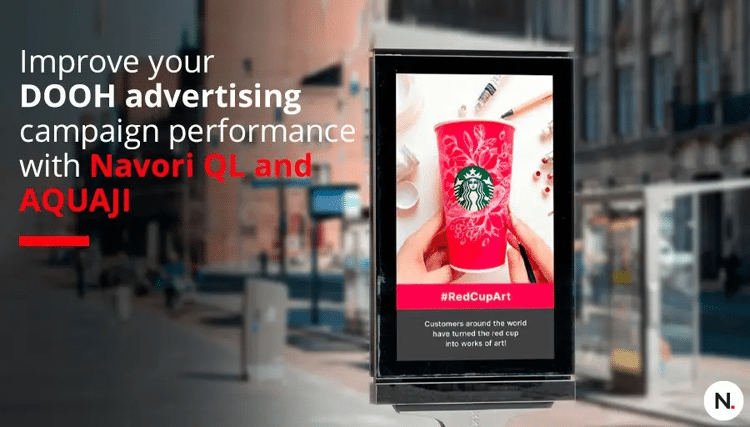Top Digital Signage Trends for 2024

Jordan Feil, Director of Marketing at Navori Labs shares the top digital signage trends for 2024 which include cloud-based signage, data-driven digital signage, data as content and more.
Digital signage’s popularity keeps growing and it seems likely this trend will continue. Case in point, digital signage software, and hardware companies are reporting sales increases since the beginning of the year. The current trends today seem to be centered around cloud-hosted platforms, data feed integrations and data-driven analytics. Here are the top digital signage trends to look out for in 2024:
The future is in the cloud
Cloud-based digital signage’s popularity continues to grow at a rapid pace. Once again, we expect to see an increasing number of businesses switch to cloud-based digital signage from on-premise solutions.
Here’s why:
-
The cloud-based digital signage software industry is mature. It provides highly reliable and secure services for any type of signage network.
-
Businesses that switch will benefit from lower staffing costs and can scale their operations as their needs evolve.
-
Cloud-based digital signage is ideal for startups or growing businesses that don’t need their own backend servers. These are companies that lack the proper technical infrastructure. Cloud-based services are ideally suited to these types of businesses.
-
Companies that choose Cloud-based digital signage software benefit from the latest in signage technology without much upfront capital.
-
Businesses can focus on their core strengths like marketing, or content creation.
-
Cloud-based digital signage offers peace of mind, stability, and predictability.

Data-driven digital signage
Ask any digital signage network operators what’s the key to their success, and most will answer: automation. To be profitable, commercial digital signage needs scale, and with scale comes a heavy workload.
Data-driven digital signage lets businesses automate highly repetitive tasks, like updating and scheduling content. Automation also simplifies content management across different signage networks. Imagine a digital signage network with hundreds of clients who need to manage their own sub-network of screens. Without automation’s help, many of these networks couldn’t cope with the workload.
Automation takes care of digital signage’s most complex, repetitive, and unpleasant tasks. This is work best done by code-driven interaction where one software application exchanges data and instructions with another one. Using automation, ad booking software can automatically insert content into a digital signage software’s playlists. A factory can display constantly updated production data on employee-facing screens in their workspace.
Let’s look at the two types of data-driven digital signage categories.
Contextualized content playback
This is when you use a live data source to decide if and where a piece of content will be shown. Take for example a business that uses an internal KPI database to display employee announcements based on the company’s performance. Or, an advertising network that shows specific ads based on the current weather conditions at each screen location.
Contextualized content offers a lot of advantages. It’s tied to current events so it’s “sticky”, and it’s not just tied to data. Any number of sensors, cameras, and related technologies can be used to activate or trigger content.
Activated content will show up as part of a scheduled playlist. Triggered content will displace the scheduled content entirely and once the trigger is released, screens automatically return to their scheduled programming.
Triggered content can be used to display announcements, emergency messaging, casino jackpot winners, or other time-sensitive information. It’s the best technique to attract the viewer’s attention and inform them of a current event.
Data as content
Databases are great for storing information, and this also makes them useful as a source of content. Using data as content makes a lot of sense because it requires less manual work. This means your screens display current information which is essential for the audience. It’s a digital signage industry trend that keeps gaining in popularity.
Here are some popular sources of data you can use as content for your digital signage screens:
-
Corporate data such as key performance indicators (KPIs), sales reports, manufacturing data, and other useful business information.
-
Current weather observations and weather forecasts.
-
RSS feeds from public news sources.
-
Sports scores, lottery/casino jackpot wins, and other types of infotainment.
-
Product information, features, prices, and other marketing data for retail customers.
-
Room occupancy information for education, fitness, and hospitality applications.
No one wants to spend their days updating and publishing this type of information manually. This is where data-driven content makes the most sense.

Data and Analytics
The utilization of data and analytics in conjunction with digital signage software has become a prevailing trend in the industry. By integrating data-driven insights into their digital signage strategies, businesses can gather valuable information about audience behavior, preferences, and engagement patterns. This allows them to create targeted and personalized content that resonates with viewers, ultimately enhancing the overall effectiveness of their signage campaigns.
Digital signage software equipped with analytics capabilities enables the collection of real-time data, such as viewer demographics, dwell times, and content performance metrics. These insights empower businesses to make data-backed decisions, refine their content strategies, and optimize the impact of their digital signage efforts. As the digital signage landscape continues to evolve, leveraging data and analytics has emerged as a key driver for delivering more relevant, engaging, and measurable experiences to audiences. Navori Labs is at the forefront is this trend with our integrated solution that leverages our homegrown Aquaji analytics platform.

Digital signage innovation
Constant innovation helps drive digital signage’s growth. Today’s digital signage software can seamlessly integrate with key business software applications. The goal is to deliver the right information to the right audience at the right time. Here are a couple of examples:
Corporate digital signage
Businesses generate a lot of documents. Being able to reuse business documents as digital signage content has been a game changer.
A proper commercial-grade digital signage software should offer these features:
-
Native support for presentations created in Microsoft PowerPoint or Google Slides. Having the ability to use this type of content without having to convert it first is quite useful.
-
Support for Adobe PDF files. PDF files have been around for decades. It’s become a common format for business communication so it should be supported by your digital signage software of choice.
-
Microsoft PowerBI is another essential business signage application. It’s an industry standard for sharing business intelligence information throughout the enterprise. PowerBI dashboards require two-factor authentication, which is a bit of a challenge for many digital signage software applications. Products that support this feature are ideally suited for corporate digital signage use.
Digital signage software for mobile staff
Mobile and non-desk staff must often take control of the content that’s playing on their local digital screens. In the past this would have required bringing along a laptop or calling someone back at head office. Mobile apps let on-site staff take control of their screen’s programming using their smartphone or tablet.
Being able to instantly change the content shown on digital menu boards or on customer facing screens is a game changer. For example, retail store staff can bring up videos and other useful information to answer customer questions. This can prove to be a great asset when selling big-ticket items with complex features, like vehicles or appliances.
Mobile app users can also trigger content when there is an emergency or in response to various events. You can imagine the security staff triggering an evacuation notice or an alert message right from their phone.
Having the ability to change the programming of one or more screens in any location can be extremely useful. It’s one more reason why digital signage is so helpful.

About Navori Labs QL software
Navori Labs’ QL digital signage software supports most types of content and data natively. There is less need to convert your original documents which saves both you time and money. Content can easily be imported, scheduled and published to any number of screens using any desktop PC or laptop. QL Mobile is the app you use to control your digital signage screens from any smartphone or tablet. Learn more about Digital Signage Software pricing.
Discover the latest innovations in signage at European Sign Expo 2024 Europe’s leading signage and visual communications exhibition. Taking place from 19th – 22nd March 2024 at RAI Amsterdam, Netherlands. Register to visit here and use code ESEJ407.
Topics
Interested in joining our community?
Enquire today about joining your local FESPA Association or FESPA Direct
Recent news

GenAI + POD: The Smartest Way to Add Personalised Products to Your Retail Offering in 2025
In 2025, GenAI and POD are transforming retail. Masterpiece AI empowers businesses to offer unique, AI-generated personalised products, from apparel to home decor. Customers use text prompts to create custom designs, streamlining production and boosting sales. This revolutionises customer experience and product offerings.
.png?width=550)
What qualities should visionaries in print have? With Folker Stachetzki from Brother
We speak to Folker Stachetzki, Head of Marketing at Brother about visionaries in print.

Bolstering personalisation by combining print and digital technology
Using printed material in combination with digital technologies offers more opportunities to those offering personalisation to customers. Rob Fletcher shares some recent examples of the print and digital working together to enhance the impact of personalised pieces.

European Sign Expo to highlight developments shaping the future of signage and visual communications
European Sign Expo 2025 (6 – 9 May, Messe Berlin, Germany) is weeks away and a host of leading exhibitors are all set to welcome Visionaries from across the signage and visual communications industries to their stands.